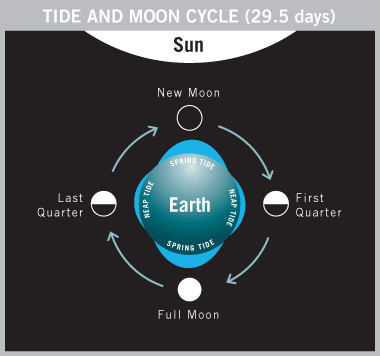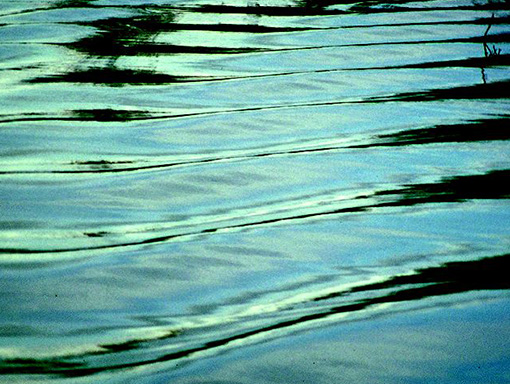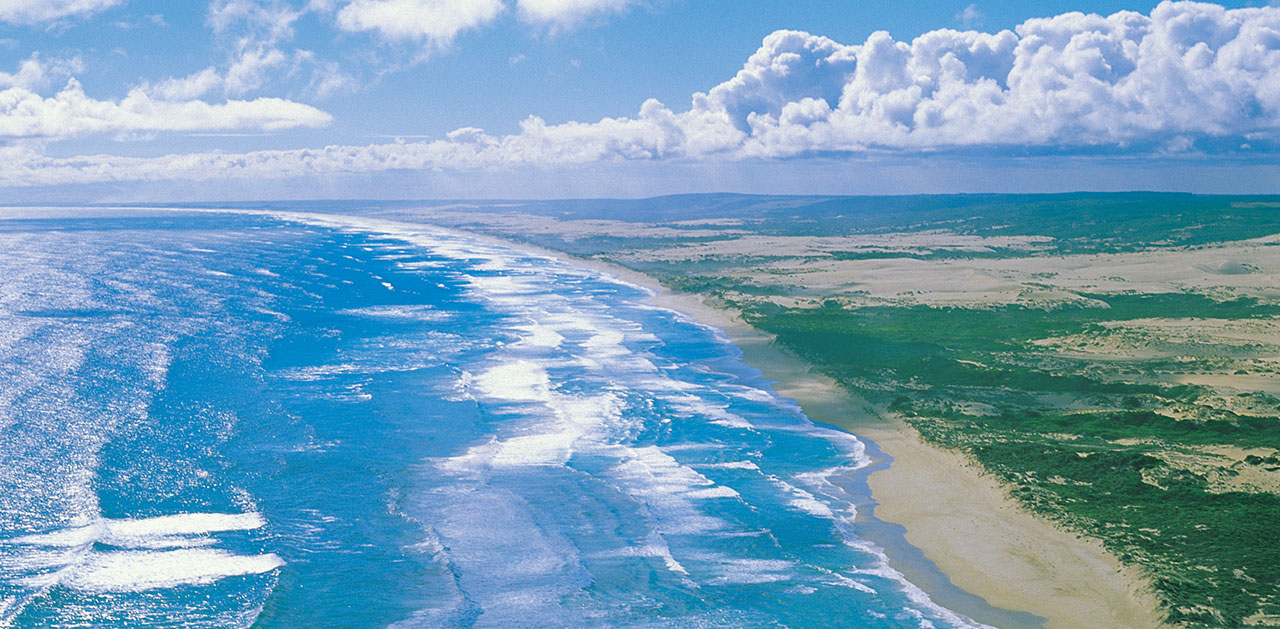
Weekly tide charts for every coast in Australia for publication by websites and newspapers.
Printed annual calendars for NSW and Victoria.
To purchase printed Ocean Calendar tide charts visit our Online store. Retail and wholesale details below.
Website and newspaper editors may contact us here.
- For swimmers, surfers, anglers, sailors, beachcombers and ocean lovers of all kinds
- Every white rectangle represents a day at the beach, from dawn to dusk
- Easy to read and with more information than tide tables or phone apps
- 12 month calendars. Plus November and December from preceding year
- Official data from the National Tidal Centre, Bureau of Meteorology
- All times preadjusted for daylight savings. Local tide variances included
Victoria

Actual Size 31 cm x 90 cm
6 months a side
New South Wales

Actual Size 31 cm x 90 cm
6 months a side
Sales Information
Mail Order
- To purchase Ocean Calendar tide charts visit our online store
- Pay by credit card or Paypal. Discount for purchase of three or more.
- Nov and Dec of previous year included.
Retail
- Ocean Calendars are available in coastal newsagencies and at selected surf, tackle and boating outlets.
- Victorian calendar $22.95 inc. gst
- NSW Calendar $22.95 inc. gst
Wholesale
- For wholesale inquiries email here.
- Newsagent and sub agent distribution by Are Direct. Ph 1300 650 666
Ocean Knowledge
Tides
Boats, fish, beaches and waves are all affected by the tides, but few people know how tides really work.
Extra low tides can cause problems for boating, but they can be a blessing for fisherman and beachcombers. Many waves surf better on a low tide. Some waves only work on a high tide. And it is common knowledge among fisherman that a change of tide is a good time to fish. The still water around tide changes also makes for good diving, snorkeling and swimming.
What causes the tides?
The tides are caused primarily by the gravitational pulls of the moon and the sun in relation to the gyration of the earth. The moon has about twice the pull of the sun. The high tide is a bulge in the ocean as the earth passes beneath the pull of the moon. There is an equivalent bulge on the opposite side of the earth to the moon. So in roughly 24 hours, any given point on earth or in the ocean passes twice beneath the pulling power of the moon. That’s why along many, but not all, coasts there are roughly two high tides and two low tides in a roughly 24-hour period.
When the moon aligns with the sun, as it does during new and full moons, the gravitational pull of the moon and the sun combine, pulling on the ocean to make higher and lower tides. These more extreme tides are called spring tides. When the moon is perpendicular to the sun in relation to earth, the pulls negate each other a bit, and there are average tides called neap tides. (See below for more on this.)
The tide (or the expansion in the ocean) responds to the moon, but the moon also orbits, moving much more slowly around the earth in the same direction as the earth rotates (west to east), every 27.3 sidereal days. This means it rotates 13 degrees (out of 360 degrees) around the earth during every earth day. Thirteen degrees equates to about 50 minutes. This in turn means any one place on earth takes 24 hours and 50 minutes to rotate to be directly under the moon again. That is why the average tide cycle is 24 hours and 50 minutes, or 12 hours and 25 minutes between high and high tide and 6 hours and 12 minutes between high and low tide or low and high tide. It is also why the moon appears to rise about 50 minutes later each day, and the tides occur around 50 minutes later each day.
The moon pulls up a high tide, so if you are out at sea, and the moon is directly above, you know it will soon be high tide.
Along coasts that run north-south and are exposed to the open ocean, the tides flood in (and ebb out) at roughly the same time.
This is why tide times are almost the same all along the NSW coast, and, according to the Queensland Department of Transport, as far north as Noosa Heads. (State tidal authorities do not produce tide charts that cross border, but the ocean knows no borders.) For this reason the Ocean Calendar for NSW can be used along the south-eastern Queensland coast from the Gold Coast up to Fraser Island. (Because there is no daylight savings in Queensland, one hour has to be subtracted from tide times during summer for Queensland beaches.)
Since the moon rotates west to east, more slowly than the earth, the high tide often strikes more westerly points on an open lateral coast like southern Australia before moving to the east. This direction is not universal though, as coastal and underwater geography and the earth’s orbit cause tides to move in circular gyres, much as galaxies do, around what are called amphodromic points in each of the oceans.
What do the tides cause?
The ocean and everything in it is linked to the tides and thereby, to the passage of the moon. Marine life, spawning, rock pools, reefs, beaches and baths are all affected. Stronger rips, larger waves, more debris, and more erosion on higher and rising tides, just for example.
And cultures throughout history acknowledge the new moon and new moon to first quarter phase as a good time to fish, to plant, and even to do business.

Fishing by the tides
Fish spawn to cycles of the moon and many species spawn on or around the full moon, which in turn, is why smart anglers fish around the new moon. Polynesians named their days after the moon cycle and fished for certain species on certain days.
Some prefer the days before a new moon; some find better catches in the days after. Some people find the moon makes little difference. One friend who kept a four year diary of his catches, found that his strike rate was pretty even across the month, but notably worse in the last quarter phases, after the full moon.
But tide changes are great times to fish. Sunrise and sunset are also good times to fish. The adage about sharks being about at sunrise and sunset also applies to other fish, and animals in general, who like us, prefer to eat around sunset.
Accordingly, if you can line up a tide change, with sunrise or sunset, and especially around a new moon, you have the best possible conditions for catching fish. Better than any other table, The Ocean Calendar allows people to do this easily. Prawning is best on outgoing tides after dark around a new moon. Again, it’s easy with this calendar to find those nights.
Using the tides for enjoyment of the beach and beach safety
lThe NSW surf life saving association found that 75 per cent of rescues occurred during rising and high tides. That’s partly because rips are stronger on those tides, and the tides flood up the beach and across rocks, and people are caught out by them.
It is good to be aware that tides change slower around high and low tide but change quickly during mid tides, when most of the water is moving. So be extra wary on beaches during the middle of the 6-hour, 12-minute tide change from low to high. That’s often when people are caught by the tides.
Something called the rule of twelfths applies to all sine curves, including the tides. One twelfth of the water moves in the first hour, then two twelfths, then three twefths. Half the water moves in or out during the middle two hours of every tide change. 1,2,3,3,2,1
But low tides are great times to enjoy the beach, because there is more beach to enjoy, and, depending on the beach and the waves, it is often safer swimming. The rock pools are exposed more on a big low tide. They may be more likely to catch marine animals after a big high tide. Beachcombing can be best on the low tide after a big high tide. You can use the Ocean Calendar to time all these visits.
Rips and currents are affected most by wave size but also by tides. If the waves are big enough (over head) height, there will be at least one rip somewhere along every beach. Rips account for an estimated 90 per cent of drownings. It is incredible that many Australians still do not know how to spot rips or deal with them.


How weather affects the tides
High-pressure systems depress the ocean and cause lower than predicted tides. So in Summer, when there are more high pressure systems, especially during hotter days and weeks, the tides will be extra low.
Conversely, low-pressure systems allow the ocean to swell or rise and cause higher than predicted tides. (It will intrigue fisherman and surfers to know that every millibar of pressure difference equates to one centimetre in ocean height.) On shore winds and large waves, also force more water to shore and cause higher than predicted tides and earlier than predicted. Off shore winds and low swells reduce and delay the tides.

What’s the difference between spring tides, king tides and tsunamis?
When sun and moon and earth are in a line, around full moon and new moon, the gravitation pull on the ocean is greatest. That means, around full and new moons, and in fact, just after the full and new moon because the ocean takes a bit to catch up, the tides are the most extreme.
We call these fortnightly tides, “Spring” tides, and the more average fortnightly tides, during quarter moon phases, “Neap” tides. But better names would be “big moon tides” and “halfmoon tides”. (You can see the effect of the moon phases on The Ocean Calendar. You can also see how every second tide in a 24-hour period is lower).
King tides are just extremely high Spring tides. The highest Spring tides occur twice a year, during the day in on of the summer months and during the night in winter months. Which month depends on when the moon is closest to the earth and the earth is closest (or furthest) from the Sun.
In addition, large Spring tides can be caused by very low-pressure systems, big swells, waves and on shore winds. These weather conditions may occur out to sea and still increase in shore tides.
What do spring and king tides mean for ocean sport lovers?
During spring or extreme tides, water rushes in and out faster. This causes stronger rips and currents and has a greater effect on the size of waves and the movement of fish.
On the Ocean Calendar, you can see that some months and some moons have more extreme tides than others. It is also possible to see that the most extreme tides occur in the days AFTER the full and new moons, not before.
Every inlet or estuary has different delays according to the width of the opening to the ocean. Inlets and river mouths delay the tide times by minutes or hours according to the width and depth of their opening to the sea. The further up river, the longer the delay, and the smaller the tide height range.
River mouths in general, reduce the tide height range upriver. So the tide height range up the Clarence River is less than on the ocean beaches.
The ocean tides take, on average, 2 hours to reach Maclean. But this delay, supplied by the Manly Hydraulics Laboratory, is an annual average only. All average delays, especially those over one hour, will vary considerably from week to week and even day to day. If the river mouth silts up, and there is a high-pressure system overhead, tides may be delayed more than two hours, for example. So open ocean and coastal tide times remain more accurate, than tide times for rivers and bays.
There are many ways that different beach and ocean lovers (and professional anglers and seafood farmers) use the tides, and we at Ocean calendars are keen to collate all stories. We know a kayaker who uses The Ocean Calendar to explore little creeks on the Hawkesbury on very high tides. We know anglers who target rocks and reefs that are only accessible on the lowest of tides. And surfers who surf breaks for a short while on the highest tides.
We invite all readers and listeners to send in comments, observations and questions.
We invite all readers and listeners to send in comments, observations and questions. Email us here
Rips
How to avoid the greatest killer at Australian beaches
Rips are not dangerous if you know what to do but most Australians do not know how to spot a rip and panic when they get caught in one.
A rip is a narrow channel of water that streams out from the beach through the wave zone, sometimes at an angle, back to sea. Rips form because water rushing in to shore must force a path or channel back out to sea.
If you are caught in one, all you have to do is swim across, parallel to the shore or the horizon, until the pull diminishes, and you can swim back into the shore. Just don’t try to swim directly against the current.

There are two ways to avoid rips
One is to swim between the red and yellow flags on patrolled beaches.
The other is to look for rips, preferably from atop the dunes, before you decide where to swim.
Waves rarely break in rips so a constant break in the lines of whitewater, or consistently smaller waves, can be signs of a rip. The surface of the water in rips is choppier than the surrounding water. It looks agitated. Rips often occur close to reefs, headlands or rocky bluffs. The bigger the waves, the stronger will be the rips. Rips can change position during the day and are often worse on rising tides.
But if you feel yourself being pulled out by one, don’t panic, be patient. Rips never go more than about 150 metres out to sea. Wave for assistance then calmly swim across shore until out of the pull of the rip (or among breaking waves) so you can swim back to shore.

Tsunamis

Tsunamis were once wrongly called “tidal waves”.
Tsunamis are caused by seismic disturbances underneath the ocean or on land near the ocean. These can be faults, tremors, landslides or volcanic eruptions. On rare occasions they have been caused by meteors crashing into the ocean. Tsunamis are waves – shock waves. They have nothing to do with tides which are caused by astronomical orbits.
Tsunamis have nothing to do with tides. However, if the Ocean Calendar shows a rising tide, and the tide is going out, or the Ocean Calendar shows a falling tide, but the tide is coming in, you know something is seriously wrong with the ocean.